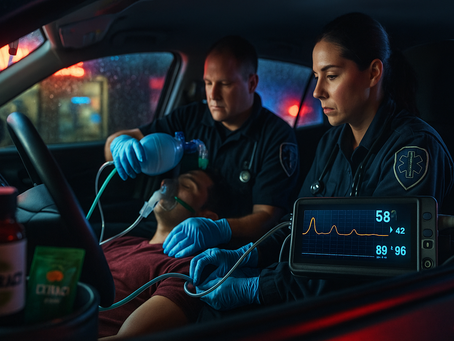top of page
Search


Field Brief: Xylazine & Emerging Non-Opioid Street Drugs
Xylazine – also known by street names like “tranq” or “tranq dope” – is a veterinary sedative that has rapidly infiltrated the illicit drug supply in recent years. Unlike opioids, xylazine is not intended for human use, yet it’s being combined with fentanyl and other drugs, causing unprecedented challenges for emergency medical services (EMS).
This report provides a comprehensive overview of xylazine and similar emerging non-opioid drugs tailored for EMS.

John Gomez
3 days ago64 min read


Black Flag EMS Scenario Saturday: Collapse at the Construction Site
It’s 1430 hours when your crew is dispatched to a construction site for a worker who “passed out.”

John Gomez
Oct 42 min read


TXA in Trauma: What You Need to Know from the New Joint Position Statement (2025)
In August 2025, a major joint position statement was released by NAEMSP, ACEP, and the ACS Committee on Trauma regarding tranexamic acid (TXA) use in trauma care. This represents one of the most unified and significant updates to prehospital hemorrhage management in recent years. Here’s what every EMS clinician should know:

John Gomez
Oct 33 min read


National Coffee Day: Why Your Cup of Coffee Matters More Than You May Know
Every shift starts with a cup. For EMS, coffee isn’t just a beverage—it’s part of the culture that fuels early mornings, 24-hour shifts, and the unpredictable chaos of answering the call. But what if your daily cup could do more than just keep you awake? What if it could train better medics and save more lives?
That’s exactly why we launched Black Flag EMS Coffee.

John Gomez
Sep 293 min read


7‑OH in the Field: A Street‑Level Guide for BLS and ALS
7‑OH (7‑hydroxymitragynine) is the potent opioid metabolite in kratom. It depresses respirations, responds to naloxone, and relapses after short wins. Treat it like an opioid tox with extra vigilance for co‑ingestants and rebound sedation.

John Gomez
Aug 155 min read


The New Opioid Battlefield: Fentanyl, Exposure, and the Fight to Save Lives
In this article, we break down three critical realities every first responder, law enforcement officer, and pre-hospital provider must understand:
The rise of fentanyl analogs and nitazenes
The truth about aerosolized opioid exposure
The clinical justification for stacking Narcan—and why mocking responders can be deadly

John Gomez
Jul 305 min read


Conscious But Pulseless: The Complex Case of CPR Induced Consciousness
CPR-induced consciousness (CPRIC) refers to instances where patients exhibit signs of awareness during chest compressions in cardiac arrest. These signs may include spontaneous eye opening, limb movement, facial grimacing, or even verbal responses.

John Gomez
Apr 288 min read


Tactical Medic Maturity Model (TM3): The Emperor Has No Clothes
The Tactical Medic Maturity Model (TM3) was born—to strip away the illusions, challenge the status quo, and provide a structure for what Tactical Medics should be, do, and aspire to become.

John Gomez
Apr 285 min read


Paradox in the Cold: Hypothermia’s Deceptive Signs
Paradoxical undressing is one of the most deceptive phenomena associated with hypothermia. Patients experiencing moderate to severe hypothermia may suddenly strip off layers of clothing, despite being in freezing conditions.

John Gomez
Apr 2814 min read


Scenario Saturday: Dizziness and the Devil in the Details
You’re dispatched to a private residence for a 75-year-old female experiencing vomiting and dizziness. It’s mid-morning, and the caller—her neighbor—states she’s “not acting right.”

John Gomez
Apr 268 min read
bottom of page
